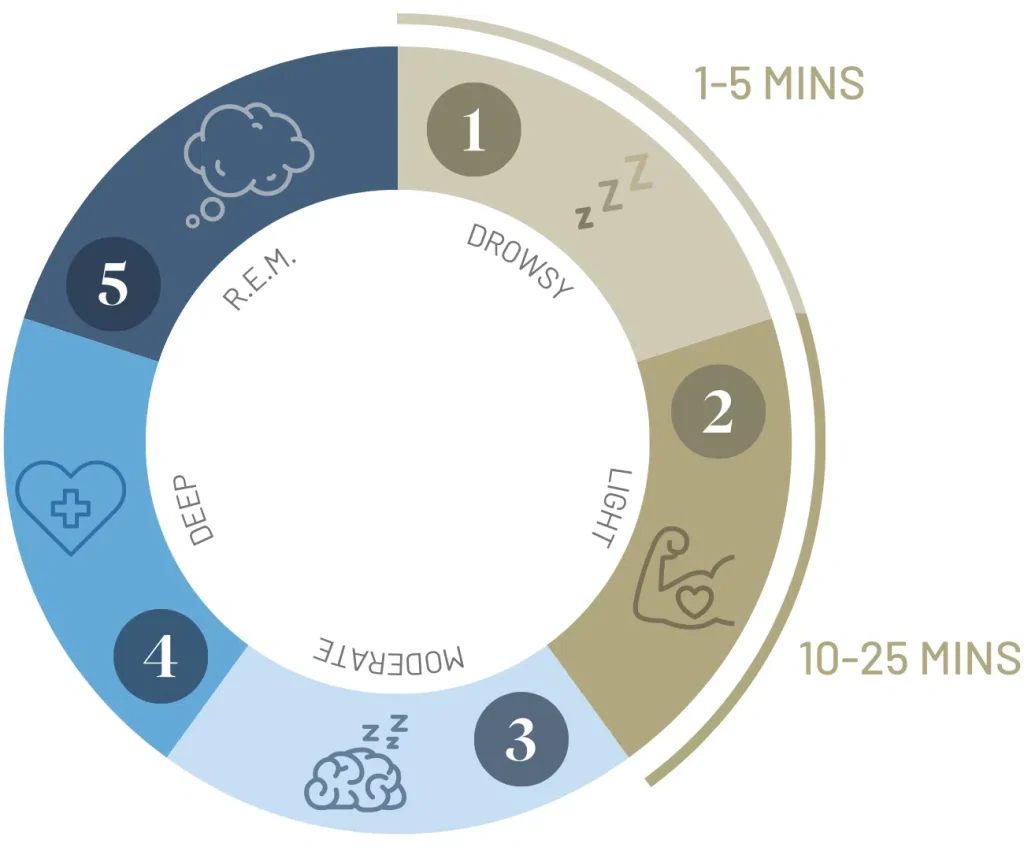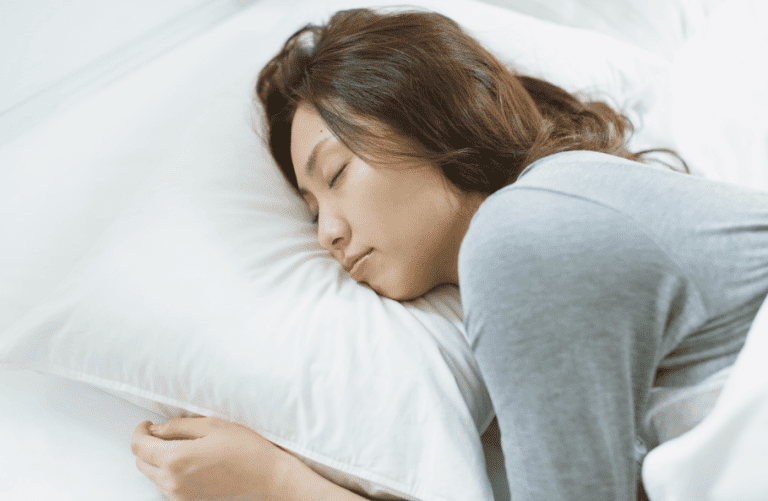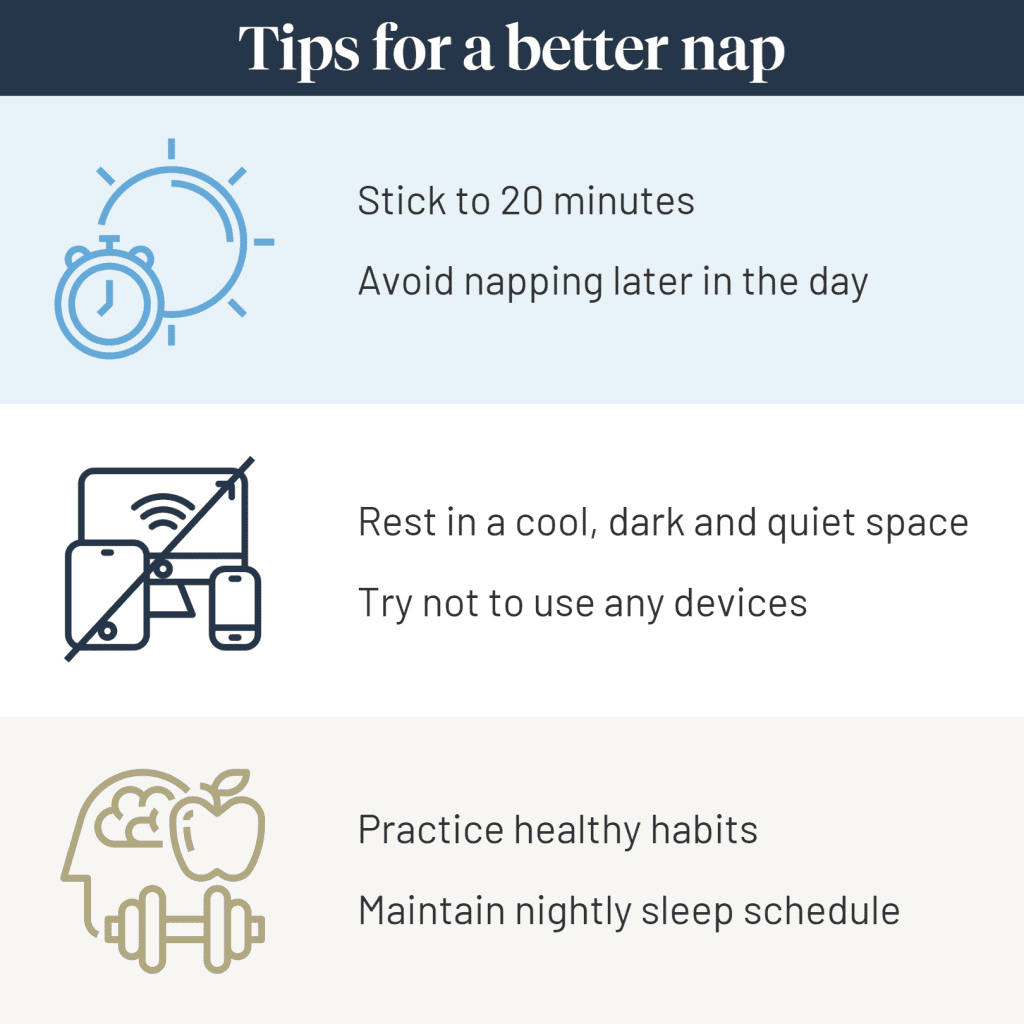Key Takeaways
A short nap can be a great way to recharge— boosting focus, mood, and energy. To get the most benefit, keep naps to 10 -25 minutes, or go for a full 90 minutes if needed. Avoid napping too late in the day, and remember: naps are a bonus, not a substitute for a good night’s sleep. Stick to a regular sleep routine and keep daytime naps short and strategic.
Feeling sluggish in the middle of the day? You’re not alone. Whether you’re tackling back-to-back meetings or juggling family errands, a nap might be just what you need to bounce back. But not all naps are created equal— how long you nap can make a big difference in how refreshed (or groggy) you feel afterward. Short naps of 10 to 25 minutes can give you a quick energy boost without the dreaded post-nap haze. On the other hand, a longer nap, around 90 minutes, lets your body go through a full sleep cycle, giving you deeper rest and helping you feel recharged.
In this post, we’ll explore how to find your ideal nap length and why timing your rest right can make all the difference in your day.
Nap Vs Sleep
When you rest, whether it’s a short nap or a full night’s sleep— your brain goes through different stages of sleep. At night, these stages cycle repeatedly in 90 to 110-minute blocks. Each cycle includes:

1. Light sleep (Stage 1): This is the drowsy stage where your muscles relax, and your heart rate starts to slow down. It’s the ideal phase for a quick nap.
2. Moderate sleep (Stage 2): Your body temperature drops, and your brain shows sleep spindles—a sign your brain is disconnecting from external stimuli.
3. Deep sleep (Stage 3): This is when your body does its heavy-duty repair work, like fixing tissues and boosting your immune system.
4. REM sleep (Stage 4): This is the dreaming stage, where your brain is highly active and your eyes move rapidly behind closed lids.
A short nap lets you enter just the early stages—enough to refresh you without dragging you into deeper sleep. This means you can wake up feeling more alert and less groggy.
But if you nap too long and drift into deep sleep, waking up mid-cycle can actually leave you feeling more tired. That’s why a full night’s sleep is structured to move through these cycles completely, giving your body and brain the full restoration they need.
Best Length for a Nap
10-25 Minute Power Naps: Quick and Effective
If your goal is to recharge without disrupting your day, a short nap of 10 to 25 minutes is your best bet. Often called a “power nap”, this light sleep keeps you in the early stages of the sleep cycle, helping to:
- Improve alertness and concentration
- Boost your mood and productivity
- Avoid grogginess
Why stop at 25 minutes? Because going beyond this duration can cause your body to slip into deeper stages of sleep, which are much harder to wake from. Waking up during these deeper stages can trigger sleep inertia—that groggy, foggy feeling where your brain feels slow and coordination is off. This can be risky if you need to drive, operate machinery, or make quick decisions right after waking.
90-Minute Naps: Full Cycle, Full Recharge
If you’ve got more time and feel like a quick nap just won’t cut it, aim for a 90-minute nap instead. This allows your body to go through an entire sleep cycle—including deep and REM sleep—and return to a lighter sleep stage before waking.
The benefits? You get the physical and mental rejuvenation of deep rest without the disorientation that can come from waking up mid-cycle. For some people, this longer nap leaves them feeling even more refreshed than a power nap, especially if they’re recovering from sleep debt.

What's Optimal for Adults and Kids?
Children and teenagers need more sleep than adults. Younger children, especially, should be napping throughout the day to meet their needs, depending on their age and routine.
Typical napping lengths and requirements for children are as follows:
- 0 – 6 months: several naps in a day, lasting 30 minutes to 2 hours
- 6 – 12 months: two naps a day, lasting 20 minutes to a few hours
- 1 – 3 years: one or two naps a day, lasting up to 2 hours
- 3 – 5 years: one nap lasting up to 2 hours
- 5 – 12 years: a small nap if needed

Children will gradually reduce the amount of time they need for naps; some may even stop feeling the need for daytime sleep altogether, especially as they start kindergarten and primary school. Teenagers should also be encouraged to take naps when they are able to, if they are feeling tired or deprived of sufficient rest.
As for adults:
- Pressed for time or need to stay sharp? Go for 10-25 minutes.
- Need a deeper recharge? Block out 90 minutes to complete a full sleep cycle.
Avoid the in between, napping for 30 to 60 minutes often leads to waking up mid-deep sleep, which can make you feel worse than before.
When's the Best Time to Nap
A well-timed nap can do wonders for your energy, focus, and mood. But just like your nightly sleep, the when and how of napping matter more than you might think.
The ideal time to nap often depends on your personal lifestyle, health, and work schedule. If you’re managing shift work, stress, or medication that causes drowsiness, you may need to nap more frequently or at off hours to recover.
However, for most people, the best time to nap is early to mid-afternoon,typically around 1 pm to 3 pm. A helpful rule of thumb: aim to nap at least 8 hours before your bedtime to avoid interfering with your night’s sleep. For many, this means avoiding naps after 4 pm.
Late-day naps—especially if they’re long—can make it harder to fall asleep at night or reduce the quality of your sleep. So unless you’re in recovery mode, try to keep naps earlier in the day.

Benefits of Healthy Napping
Sharper Focus and Faster Reaction Times
A short nap can make you feel more alert, improve your reaction speed, and even enhance physical performance—especially helpful for athletes or those with physically demanding jobs.
Boosted Memory and Learning Ability
Napping helps consolidate memory and supports learning. If you’re a student or work in a high-focus role, a nap could help you better retain information and stay sharp throughout the day.
Better Mood and Emotional Balance
Naps don’t just help you think clearly—they can lift your mood too. A well-timed rest can make you feel more positive, reduce irritability, and lower stress levels.
Can Napping be bad?
While naps offer many benefits when done right, they aren’t always the best solution for everyone. In fact, frequent or poorly timed naps can sometimes lead to unwanted side effects.
Sleep Inertia
One of the biggest risks of napping is sleep inertia—that disoriented, sluggish feeling you get when you wake up in the middle of deep sleep. This usually happens if you nap for too long (more than 30-40 minutes)

Disrupted Sleep Cycle
Napping too close to bedtime—especially after 4 or 5 pm—can interfere with your body’s natural rhythm. This might make it harder for you to fall asleep or stay asleep through the night.
Health Concerns
If you find yourself needing a nap every single day, it could be your body’s way of telling you something isn’t right. Chronic tiredness or daytime drowsiness may be a sign of an underlying medical condition or poor sleep quality at night.
Too Much or Too Little Sleep
For most healthy adults, the sweet sport lies between 7 to 9 hours of quality sleep per night. Straying too far on either side—whether you’re sleeping too little or indulging in long, frequent naps—can lead to a range of physical and mental health concern.
Oversleeping isn’t just about feeling sluggish the next day—it can point to deeper health issues or even make existing conditions worse. Long-term over sleeping (including excessive daytime naps) has been linked to:
- Obesity
- Headaches and back pain
- Anxiety and depression
- Higher risk of diabetes and heart disease
On the flip side, skimping on sleep—whether due to a packed schedule, stress, or poor sleep habits—can have immediate and long-term effects on your health.
- Weight gain and food cravings
- Mood swings, irritability, or depression
- Lowered libido and motivation
- Poor memory and concentration
- High blood pressure and weakened immune function
- Poor coordination and reaction time
- Increased risk of diabetes and heart disease
Tips for Napping

1. Time it right
Keep naps to around 20 minutes and aim for early to mid-afternoon, ideally around 2pm or at least 8 hours before bedtime. Napping too late can mess with your night’s sleep.
2. Set up your space
Choose a cool, quiet, and dark spot. A comfy chair or sofa works better than your bed to avoid oversleeping. Skip the screens—just set an alarm and wind down.
3. Keep your health in check
Naps aren’t a replacement for real sleep. Adults still need 7-9 hours of rest at night. If you’re always tired or relying on naps, it might be time to check your sleep routine—or see a doctor.
FAQs on Naps
A 45-minute nap is not ideal. After 20 minutes, your body enters deeper sleep. Waking in the middle of this stage leads to sleep inertia or increased grogginess. You may struggle to wake up and are likely to feel more tired after a 45-minute nap.
Yes, a 1-hour nap is generally too long. After about 20 minutes, your body enters deep sleep, and waking up during this stage often causes sleep inertia—that groggy, disoriented feeling that’s hard to shake off.
Yes, 2-hour naps are too long. To feel refreshed without side effects, stick to a 20-minute power nap or a 90-minute nap to complete a full sleep cycle
Yes. A 4-hour nap is more like a second sleep and can heavily disrupt your circadian rhythm. It’s not recommended unless you’re recovering from extreme sleep loss or illness.
Yes, in most cases. A 30-minute nap lets you benefit from light sleep without going too deep, making it easier to wake up. A 2-hour nap, while longer, often interferes with night-time sleep and can cause grogginess.
A nap is typically 10 to 90 minutes. Anything longer edges into full sleep territory and can mess with your sleep-wake rhythm. The most effective naps are around 20 minutes or a full 90-minute cycle.
- 10–25 minutes for a quick energy boost
- 90 minutes for deeper recovery and cognitive benefits
Avoid anything in between unless you’re okay with a bit of grogginess upon waking.





